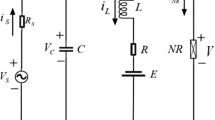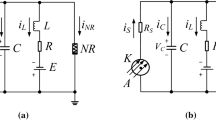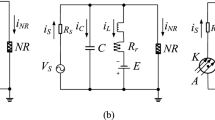Abstract
A functional neuron has been developed from a simple neural circuit by incorporating a phototube and a thermistor in different branch circuits. The physical field energy is controlled by the photocurrent across the phototube and the channel current across the thermistor. The firing mode of this neuron is controlled synchronously by external temperature and illumination. There is energy diversity when two functional neurons are exposed to different illumination and temperature conditions. As a result, synapse connections can be created and activated in an adaptive way when field energy is exchanged between neurons. We propose two kinds of criteria to discuss the enhancement of synapse connections to neurons. The energy diversity between neurons determines the increase of the coupling intensity and synaptic current for neurons, and the realization of synchronization is helpful in maintaining energy balance between neurons. The first criterion is similar to the saturation gain scheme in that the coupling intensity is increased with a constant step within a certain period until it reaches energy balance or complete synchronization. The second criterion is that the coupling intensity increases exponentially before reaching energy balance. When two neurons become non-identical, phase synchronization can be controlled during the activation of synapse connections to neurons. For two identical neurons, the second criterion for taming synaptic intensity is effective for reaching complete synchronization and energy balance, even in the presence of noise. This indicates that a synapse connection may prefer to enhance its coupling intensity exponentially. These results are helpful in discovering why synapses are awaken and synaptic current becomes time-varying when any neurons are excited by external stimuli. The potential biophysical mechanism is that energy balance is broken and then synapse connections are activated to maintain an adaptive energy balance between the neurons. These results provide guidance for designing and training intelligent neural networks by taming the coupling channels with gradient energy distribution.
摘要
在一类简单的神经元电路不同支路嵌入光电管和热敏电阻来设计一种功能性神经元. 通过光电管的光电流和流经热敏电阻的通道电流可以控制神经元电路的场能量. 神经元的放电模态同时依赖于外界光照和温度. 在不同的光照和温度刺激下, 两个功能神经元存在能量差. 因此, 在场能量传递和交换过程中神经元之间开始建立突触连接并相互耦合. 我们提出两种规则来讨论神经元之间突触耦合增强问题, 神经元之间的能量差控制着神经元之间突触耦合强度的增长和突触电流变化, 且神经元之间的同步有利于维持神经元之间的能量平衡. 第一类规则类似于饱和增益法, 即神经元在达到完全同步之前其突触耦合强度以恒定的增益周期性增长. 第二类规则指出神经元突触耦合强度以恰当的增益呈现指数型增长, 直到神经元之间达到能量平衡. 两个不同的神经元在突触耦合增强的过程中可以实现相位同步. 两个完全相同的神经元即使在噪声环境下, 神经元耦合突触按照第二类规则增长强度依旧可以有效实现完全同步和能量平衡. 此结果表明神经元突触更倾向于以指数型方式来增长其耦合强度. 这些研究结果有助于揭示外界刺激如何唤醒和激活神经元之间的突触连接, 进一步理解突触耦合电流时变的特性. 潜在的生物物理机制在于外界差异性的刺激打破了神经元之间的能量平衡, 因此突触耦合不断被增强来实现神经元之间能量动态平衡. 这些研究结果为设计和训练智能神经元电路提供了思路, 即通过设置梯度性能量分布来调控耦合通道.
Similar content being viewed by others
References
An XL, Zhang L, 2018. Dynamics analysis and Hamilton energy control of a generalized Lorenz system with hidden attractor. Nonl Dynam, 94(4):2995–3010. https://doi.org/10.1007/s11071-018-4539-9
Andreev A, Makarov V, Runnova A, et al., 2017. Coherent resonance in neuron ensemble with electrical couplings. Cybern Phys, 6(3):145–148.
Ansariara M, Emadi S, Adami V, et al., 2020. Signs of memory in a plastic frustrated Kuramoto model of neurons. Nonl Dynam, 100(4):3685–3694. https://doi.org/10.1007/s11071-020-05705-4
Baysal V, Saraç Z, Yilmaz E, 2019. Chaotic resonance in Hodgkin-Huxley neuron. Nonlinear Dyn, 97(2): 1275–1285. https://doi.org/10.1007/s11071-019-05047-w
Blankenburg S, Wu W, Lindner B, et al., 2015. Information filtering in resonant neurons. J Comput Neurosci, 39(3): 349–370. https://doi.org/10.1007/s10827-015-0580-6
Breakspear M, Heitmann S, Daffertshofer A, 2010. Generative models of cortical oscillations: neurobiological implications of the Kuramoto model. Front Human Neurosci, 4:190. https://doi.org/10.3389/fnhum.2010.00190
Cumin D, Unsworth CP, 2007. Generalising the Kuramoto model for the study of neuronal synchronisation in the brain. Phys D, 226(2):181–196. https://doi.org/10.1016/j.physd.2006.12.004
Daniels BC, Dissanayake STM, Trees BR, 2003. Synchronization of coupled rotators: Josephson junction ladders and the locally coupled Kuramoto model. Phys Rev E, 67(2): 026216. https://doi.org/10.1103/PhysRevE.67.026216
Deng B, Wang J, Wei X, 2009. Effect of chemical synapse on vibrational resonance in coupled neurons. Chaos, 19:013117. https://doi.org/10.1063/1.3076396
Du MM, Li JJ, Yuan ZX, et al., 2020. Astrocyte and ions metabolism during epileptogenesis: a review for modeling studies. Chin Phys B, 29(3):038701. https://doi.org/10.1088/1674-1056/ab6961
Guo YT, Zhou P, Yao Z, et al., 2021. Biophysical mechanism of signal encoding in an auditory neuron. Nonl Dynam, 105(4):3603–3614. https://doi.org/10.1007/s11071-021-06770-z
He ZW, Yao CG, Liu S, et al., 2021. Transmission of pacemaker signal in a small world neuronal networks: temperature effects. Nonl Dynam, 106(3):2547–2557. https://doi.org/10.1007/s11071-021-06907-0
Herz AVM, Gollisch T, Machens CK, et al., 2006. Modeling single-neuron dynamics and computations: a balance of detail and abstraction. Science, 314(5796):80–85. https://doi.org/10.1126/science.1127240
Leutcho GD, Khalaf AJM, Njitacke Tabekoueng Z, et al., 2020. A new oscillator with mega-stability and its Hamilton energy: infinite coexisting hidden and self-excited attractors. Chaos, 30(3):033112. https://doi.org/10.1063/1.5142777
Lin HR, Wang CH, Sun YC, et al., 2020. Firing multistability in a locally active memristive neuron model. Nonl Dynam, 100(4):3667–3683. https://doi.org/10.1007/s11071-020-05687-3
Lin HR, Wang CH, Deng QL, et al., 2021. Review on chaotic dynamics of memristive neuron and neural network. Nonl Dynam, 106(1):959–973. https://doi.org/10.1007/s11071-021-06853-x
Liu Y, Xu WJ, Ma J, et al., 2020. A new photosensitive neuron model and its dynamics. Front Inform Technol Electron Eng, 21(9):1387–1396. https://doi.org/10.1631/FITEE.1900606
Liu ZL, Wang CN, Zhang G, et al., 2019. Synchronization between neural circuits connected by hybrid synapse. Int J Mod Phys B, 33(16): 1950170. https://doi.org/10.1142/S0217979219501704
Liu ZL, Zhou P, Ma J, et al., 2020. Autonomic learning via saturation gain method, and synchronization between neurons. Chaos Soliton Fract, 131:109533. https://doi.org/10.1016/j.chaos.2019.109533
Ma SY, Zhou P, Ma J, et al., 2020. Phase synchronization of memristive systems by using saturation gain method. Int J Mod Phys B, 34(9):2050074. https://doi.org/10.1142/S0217979220500745
McDonnell MD, Iannella N, To MS, et al., 2015. A review of methods for identifying stochastic resonance in simulations of single neuron models. Netw Comput Neur Syst, 26(2): 35–71. https://doi.org/10.3109/0954898X.2014.990064
Miller AC, Voelker LH, Shah AN, et al., 2015. Neurobeachin is required postsynaptically for electrical and chemical synapse formation. Curr Biol, 25(1): 16–28. https://doi.org/10.1016/j.cub.2014.10.071
Pereira T, Baptista MS, Kurths J, et al., 2007. Onset of phase synchronization in neurons with chemical synapse. Int J Bifurc Chaos, 17(10):3545–3549. https://doi.org/10.1142/S0218127407019342
Rossant C, Goodman DFM, Fontaine B, et al., 2011. Fitting neuron models to spike trains. Front Neurosci, 5:9. https://doi.org/10.3389/fnins.2011.00009
Shilnikov A, Cymbalyuk G, 2005. Transition between tonic spiking and bursting in a neuron model via the blue-sky catastrophe. Phys Rev Lett, 94(4):048101. https://doi.org/10.1103/PhysRevLett.94.048101
Shinomoto S, Kim H, Shimokawa T, et al., 2009. Relating neuronal firing patterns to functional differentiation of cerebral cortex. PLoS Comput Biol, 5(7):e1000433. https://doi.org/10.1371/journal.pcbi.1000433
Song XL, Wang HT, Chen Y, 2019. Autapse-induced firing patterns transitions in the Morris — Lecar neuron model. Nonl Dynam, 96(4):2341–2350. https://doi.org/10.1007/s11071-019-04925-7
Szűcs A, 1998. Applications of the spike density function in analysis of neuronal firing patterns. J Neurosci Methods, 81(1–2): 159–167. https://doi.org/10.1016/S0165-0270(98)00033-8
Tang J, Zhang J, Ma J, et al., 2019. Noise and delay sustained chimera state in small world neuronal network. Sci China Technol Sci, 62(7): 1134–1140. https://doi.org/10.1007/s11431-017-9282-x
Trees BR, Saranathan V, Stroud D, 2005. Synchronization in disordered Josephson junction arrays: small-world connections and the Kuramoto model. Phys Rev E, 71(1): 016215. https://doi.org/10.1103/PhysRevE.71.016215
Ujfalussy BB, Makara JK, 2020. Impact of functional synapse clusters on neuronal response selectivity. Nat Commun, 11(1):1413. https://doi.org/10.1038/s41467-020-15147-6
Uzuntarla M, Yilmaz E, Wagemakers A, et al., 2015. Vibrational resonance in a heterogeneous scale free network of neurons. Commun Nonl Sci Numer Simul, 22(1–3):367–374. https://doi.org/10.1016/j.cnsns.2014.08.040
Uzuntarla M, Torres JJ, Calim A, et al., 2019. Synchronization-induced spike termination in networks of bistable neurons. Neur Netw, 110:131–140. https://doi.org/10.1016/j.neunet.2018.11.007
Wang XB, Xu C, Zheng ZG, 2021. Phase transition and scaling in Kuramoto model with high-order coupling. Nonl Dynam, 103(3):2721–2732. https://doi.org/10.1007/s11071-021-06268-8
Wang ZH, Wang QY, 2019. Stimulation strategies for absence seizures: targeted therapy of the focus in coupled thalamocortical model. Nonl Dynam, 96(2):1649–1663. https://doi.org/10.1007/s11071-019-04876-z
Xie Y, Yao Z, Hu XK, et al., 2021a. Enhance sensitivity to illumination and synchronization in light-dependent neurons. Chin Phys B, 30(12):120510. https://doi.org/10.1088/1674-1056/ac1fdc
Xie Y, Zhu ZG, Zhang XF, et al., 2021b. Control of firing mode in nonlinear neuron circuit driven by photocurrent. Acta Phys Sin, 70(21):210502 (in Chinese). https://doi.org/10.7498/aps.70.20210676
Xu L, Qi GY, Ma J, 2022. Modeling of memristor-based Hindmarsh-Rose neuron and its dynamical analyses using energy method. Appl Math Model, 101:503–516. https://doi.org/10.1016/j.apm.2021.09.003
Xu Y, Liu MH, Zhu ZG, et al., 2020. Dynamics and coherence resonance in a thermosensitive neuron driven by photocurrent. Chin Phys B, 29(9):098704. https://doi.org/10.1088/1674-1056/ab9dee
Yang CZ, Liu ZL, Wang QS, et al., 2021. Epilepsy as a dynamical disorder orchestrated by epileptogenic zone: a review. Nonl Dynam, 104(8):1901–1916. https://doi.org/10.1007/s11071-021-06420-4
Yang N, Ng YH, Pang ZP, et al., 2011. Induced neuronal cells: how to make and define a neuron. Cell Stem Cell, 9(6): 517–525. https://doi.org/10.1016/j.stem.2011.11.015
Yang XL, Li N, Sun ZK, 2019. Extended analysis of stochastic resonance in a modular neuronal network at different scales. Nonl Dynam, 98(2):1029–1039. https://doi.org/10.1007/s11071-019-05246-5
Yao CG, Ma J, He ZW, et al., 2019. Transmission and detection of biharmonic envelope signal in a feed-forward multilayer neural network. Phys A, 523:797–806. https://doi.org/10.1016/j.physa.2019.02.053
Zandi-Mehran N, Jafari S, Golpayegani SMRH, et al., 2020. Different synaptic connections evoke different firing patterns in neurons subject to an electromagnetic field. Nonl Dynam, 100(2):1809–1824. https://doi.org/10.1007/s11071-020-05576-9
Zhang XF, Wang CN, Ma J, et al., 2020. Control and synchronization in nonlinear circuits by using a thermistor. Mod Phys Lett B, 34(25):2050267. https://doi.org/10.1142/S021798492050267X
Zhang XF, Yao Z, Guo YY, et al., 2021. Target wave in the network coupled by thermistors. Chaos Sol Fract, 142:110455. https://doi.org/10.1016/j.chaos.2020.110455
Zhang Y, Wang CN, Tang J, et al., 2020. Phase coupling synchronization of FHN neurons connected by a Josephson junction. Sci China Technol Sci, 63(11):2328–2338. https://doi.org/10.1007/s11431-019-1547-5
Zhou P, Hu XK, Zhu ZG, et al., 2021. What is the most suitable Lyapunov function? Chaos Sol Fract, 150:111154. https://doi.org/10.1016/j.chaos.2021.111154
Zhou Q, Wei DQ, 2021. Collective dynamics of neuronal network under synapse and field coupling. Nonl Dynam, 105(1): 753–765. https://doi.org/10.1007/s11071-021-06575-0
Author information
Authors and Affiliations
Contributions
Jun MA designed the research. Ying XIE and Zhao YAO processed the data. Jun MA drafted the paper. Zhao YAO helped organize the paper. Zhao YAO and Jun MA revised and finalized the paper.
Corresponding author
Ethics declarations
Ying XIE, Zhao YAO, and Jun MA declare that they have no conflict of interest.
Additional information
Project supported by the National Natural Science Foundation of China (No. 12072139)
Rights and permissions
About this article
Cite this article
Xie, Y., Yao, Z. & Ma, J. Phase synchronization and energy balance between neurons. Front Inform Technol Electron Eng 23, 1407–1420 (2022). https://doi.org/10.1631/FITEE.2100563
Received:
Accepted:
Published:
Issue Date:
DOI: https://doi.org/10.1631/FITEE.2100563




